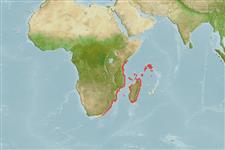>
Scombriformes (Mackerels) >
Scombridae (Mackerels, tunas, bonitos) > Scombrinae
Etymology: Scomberomorus: Latin, scomber = mackerel + Greek, moros = silly, stupid (Ref. 45335).
Environment: milieu / climate zone / depth range / distribution range
Ecologie
marien; oceanodroom (Ref. 51243); diepte 50 - 200 m. Subtropical; 1°S - 37°S, 23°E - 59°E (Ref. 168)
Western Indian Ocean: Seychelles, Kenya and Zanzibar to South Africa and along the west coast of Madagascar. This species has been confused with Scomberomorus lineolatus and with Scomberomorus guttatus (and also one of its junior synonyms Scomberomorus leopardus).
Lengte bij maturiteit / Grootte / Gewicht / Leeftijd
Maturity: Lm ?, range 80 - ? cm
Max length : 120 cm FL mannelijk / geslacht onbekend; (Ref. 168); max. gepubliceerd gewicht: 12.5 kg (Ref. 40637)
Korte beschrijving
Determinatiesleutels | Morfologie | Morfometrie
Dorsale stekels (totaal) : 15 - 17; Dorsale zachte stralen (totaal) : 19 - 21; Anale zachte stralen: 19 - 22; Wervels: 45 - 46. Interpelvic process small and bifid. Body covered with small scales. Lateral line without auxiliary branches anteriorly, gradually curving down toward caudal peduncle. Intestine with 2 folds and 3 limbs. Juveniles have spots but develop adult pattern of interrupted lines by the time they reach 40 cm.
Neritic species (Ref. 5313). Forms large schools in the Zanzibar Channel from March to September. Feeds mainly on anchovies (Anchoviella sp.), clupeids (Amblygaster sp., Sardinella fimbriata, Sardinella perforata [= Sardinella albella), other small fishes, squids, and mantis shrimps.
Levenscyclus en paargedrag
Maturiteit | Voortplanting | Paaien | Eieren | Fecunditeit | Larven
Collette, B.B. and C.E. Nauen, 1983. FAO Species Catalogue. Vol. 2. Scombrids of the world. An annotated and illustrated catalogue of tunas, mackerels, bonitos and related species known to date. Rome: FAO. FAO Fish. Synop. 125(2):137 p. (Ref. 168)
Status op de Rode Lijst van het IUCN (Ref. 130435: Version 2024-1)
Gevaar voor de mens
Harmless
Gebruik door de mens
Visserij: commercieel; sportvis: ja
Tools
Speciale rapporten
Download XML
Internetbronnen
Estimates based on models
Preferred temperature (Ref.
123201): 20.4 - 25.4, mean 21.8 °C (based on 19 cells).
Fylogenetische diversiteitsindex (Ref.
82804): PD
50 = 0.5000 [Uniqueness, from 0.5 = low to 2.0 = high].
Bayesian length-weight: a=0.00871 (0.00439 - 0.01729), b=3.02 (2.86 - 3.18), in cm total length, based on LWR estimates for this species & Genus-body shape (Ref.
93245).
Trofisch niveau (Ref.
69278): 4.2 ±0.77 se; based on food items.
Generation time: 1.9 ( na - na) years. Estimated as median ln(3)/K based on 1
growth studies.
Weerstandsvermogen (Ref.
120179): Gemiddeld, minimale populatieverdubbelingstijd 1,4-4,4 jaar (tm=2).
Fishing Vulnerability (Ref.
59153): Moderate vulnerability (39 of 100).
Nutrients (Ref.
124155): Calcium = 20.3 [8.9, 71.4] mg/100g; Iron = 0.893 [0.392, 2.210] mg/100g; Protein = 21.3 [20.0, 22.6] %; Omega3 = 0.411 [0.259, 0.665] g/100g; Selenium = 36.9 [13.0, 113.7] μg/100g; VitaminA = 9.34 [2.03, 46.45] μg/100g; Zinc = 0.419 [0.273, 0.700] mg/100g (wet weight);
